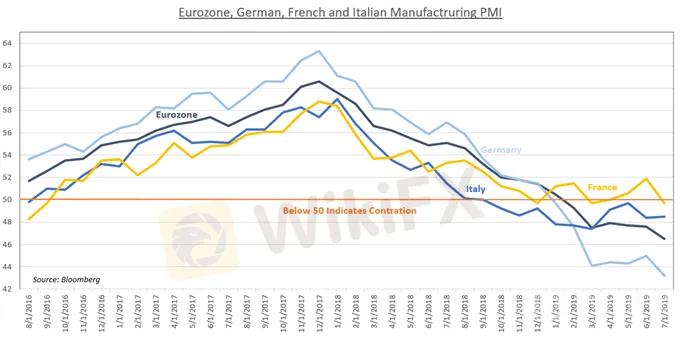简体中文
繁體中文
English
Pусский
日本語
ภาษาไทย
Tiếng Việt
Bahasa Indonesia
Español
हिन्दी
Filippiiniläinen
Français
Deutsch
Português
Türkçe
한국어
العربية
Euro May Fall on ECB Minutes, Jackson Hole and Eurozone PMIs
Abstract:The Euro may fall against the US Dollar if ECB minutes carry ultra-dovish undertones and commentary from Jackson Hole spooks markets against the backdrop of Eurozone PMI data.
US Dollar, Euro, Jackson Hole, Eurozone PMIs – TALKING POINTS
Euro may fall vs. US Dollar if ECB minutes evoke ultra-dovish expectations
Eurozone PMIs may exacerbate regional growth fears and undermine Euro
Official commentary on growth outlook at Jackson Hole may spook markets
The Euro may suffer against the US Dollar if the release of the ECB minutes reveal stronger-than-expected dovish inclinations against the backdrop of Eurozone PMI publications. Regional growth concerns have been mounting as Germany – Europes largest economy – is expected to show a contraction in Q2. Comments from officials at the Jackson Hole symposium may also stoke growth fears and boost the anti-risk USD vs the Euro.
Jackson Hole Symposium
Markets will be closely watching the Jackson Hole symposium for comments from officials regarding the growth outlook. The release of the FOMC meeting minutes revealed that trade war concerns remain a “persistent headwind” and low inflation remain key obstacles along with corporate debt and leveraged lending. The latter has begun to sound the alarm as the collateralized loan obligation market stirs familiar fears.
European Growth Concerns, Political Instability
If comments from the Jackson Hole symposium carry overwhelming undertones of uncertainty, the Euro may fall against its US Dollar counterparts. EURUSDs decline may be amplified if Eurozone PMI data reinforces the fear that the Eurozone is significantly decelerating in its growth prospects. As it stands, Germany is planning on implementing stimulative policies as a contingency for a crisis ahead.
Europe is also dealing with chronic political upset in both the mainland and overseas. The latter is referring to the ongoing Brexit negotiations that remain unclear despite the October 31 deadline approaching. Italian political volatility and another possible budget dispute in the same month may magnify market volatility. During times of economic uncertainty, the capacity for political shocks to disrupt markets is notably increased.
CHART OF THE DAY: Weak European Manufacturing PMI May Spill Over into Services Soon

FX TRADING RESOURCES
Disclaimer:
The views in this article only represent the author's personal views, and do not constitute investment advice on this platform. This platform does not guarantee the accuracy, completeness and timeliness of the information in the article, and will not be liable for any loss caused by the use of or reliance on the information in the article.
Read more

KVB Market Analysis | 28 August: Yen Strengthens on BoJ Rate Hike Hints; USD/JPY Faces Uncertainty
The Japanese Yen rose 0.7% against the US Dollar after BoJ Governor Kazuo Ueda hinted at potential rate hikes. This coincided with a recovery in Asian markets, aided by stronger Chinese stocks. With the July FOMC minutes already pointing to a September rate cut, the US Dollar might edge higher into the weekend.

KVB Market Analysis | 27 August: AUD/USD Holds Below Seven-Month High Amid Divergent Central Bank Policies
The Australian Dollar (AUD) traded sideways against the US Dollar (USD) on Tuesday, staying just below the seven-month high of 0.6798 reached on Monday. The downside for the AUD/USD pair is expected to be limited due to differing policy outlooks between the Reserve Bank of Australia (RBA) and the US Federal Reserve. The RBA Minutes indicated that a rate cut is unlikely soon, and Governor Michele Bullock affirmed the central bank's readiness to raise rates again if necessary to combat inflation.

KVB Market Analysis | 23 August: JPY Gains Ground Against USD as BoJ Signals Possible Rate Hike
JPY strengthened against the USD, pushing USD/JPY near 145.00, driven by strong inflation data and BoJ rate hike expectations. Japan's strong Q2 GDP growth added support. However, USD gains may be limited by expectations of a Fed rate cut in September.

KVB Market Analysis | 22 August: Gold Stays Strong Above $2,500 as Fed Rate Cut Hints Loom
Gold prices remain above $2,500, near record highs, as investors await the Federal Open Market Committee minutes for confirmation of a potential Fed rate cut in September. The Fed's dovish shift, prioritizing employment over inflation, has weakened the US Dollar, boosting gold. A recent revision showing the US created 818,000 fewer jobs than initially reported also strengthens the case for a rate cut.
WikiFX Broker
Latest News
CFI Partners with MI Cape Town, Cricket Team
Doo Financial Expands Reach with Indonesian Regulatory Licenses
Geopolitical Events: What They Are & Their Impact?
Volkswagen agrees deal to avoid Germany plant closures
Webull Canada Expands Options Trading to TFSAs and RRSPs
CySEC Launches Redesigned Website Packed with New Features
WikiEXPO Global Expert Interview: Simone Martin—— Exploring Financial Regulation Change
TradingView Launches Liquidity Analysis Tool DEX Screener
MultiBank Group Wins Big at Traders Fair Hong Kong 2024
WikiFX Review: Is PU Prime a decent broker?
Currency Calculator


